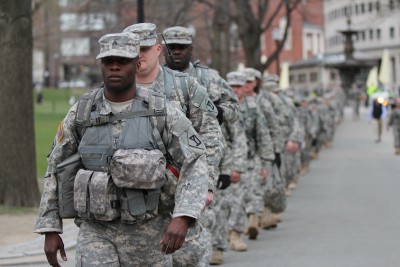A joint report examining the public safety, public health and medical response by local and state federal authorities to the 2013 Boston Marathon Bombings was released to the general public Friday, according to a press release from the Massachusetts Emergency Management Agency.

The report, titled “After Action Report for the Response to the 2013 Boston Marathon Bombings,” offers a detailed timeline of events related to the bombings that killed three people and injured more than 260 on April 15, 2013. It also identifies the best response practices to emergency response, as well as areas needing improvement.
While the report was made available to the public Friday, it was shared with “key stakeholders” before the 2014 Boston Marathon, and “most of the recommended corrective actions have been or continue to be addressed,” the release stated.
Boston Mayor Martin Walsh praised the report in a Friday statement.
“I am proud that this report highlights the tremendous efforts of so many city workers following the violence that struck our City two years ago, including the re-opening of Boylston Street in the aftermath of the bombing, and the incredible response of our hospitals and medical personnel,” Walsh said in the statement.
The Mayor’s Office of Emergency Management, an agency responsible for developing plans to prevent, protect, respond and recover from disasters and emergencies, played a part in coordinating the response to the bombings, said Matthew Benedetti, a public information officer for the OEM .
“During emergencies, OEM operates the City’s Emergency Operation Center where city agencies coordinate response and share information critical to managing the incident,” Benedetti said.
Benedetti emphasized the importance of building relationships between agencies and departments, which helped the city officials manage the response.
“Strong relationships created and maintained by key leaders were paramount to ensuring commanders, agency heads and political leaders came together quickly to form Unified Command and facilitate collaborative decision-making after the bombings in Boston and during the manhunt in Watertown,” he said.
The response by the Watertown Police Department officers, who “took heavy fire” in the days following the bombings, was highlighted as one of the best practices in the After Action Report.
“All four officers demonstrated incredible bravery and discipline under pressure, maintaining communications with their dispatch center and critically wounding the suspects,” the report stated. “Their effective tactical response ensured the residents of the neighborhood were not hurt.”
Despite the praise for the department, the report also detailed an incident of friendly fire after the car hijacking and shootout on the evening of April 18, 2013 and early morning of April 19, 2013.
“Shortly after the firefight, an unmarked Massachusetts State Police black pickup truck was erroneously reported as stolen. The truck was spotted driving on Adams Street, a few blocks from the firefight, with two occupants. An officer witnessing the vehicle fired upon it,” the release stated. “Upon further inspection, it was determined that the occupants of the vehicle were a BPD officer and MSP trooper in plain clothes. They were unhurt.”
Dzhokhar Tsarnaev, the 21-year-old former University of Massachusetts Dartmouth student who was found guilty on Wednesday of 30 federal counts associated with the bombings, escaped after the firefight, the report stated. Officials determined that suspension of transit services and request of shelter-in-place was in the best interest of public safety during the morning of April 19.
At 6:42 p.m. on April 19, a Watertown resident notified Watertown Police Department that there was a body in his boat. Three Watertown policemen and three Boston policemen responded immediately, the report stated.
At 6:54 p.m., an officer opened fire, without proper authorization, in response to “perceived movement in the boat,” the report stated. This led to “contagious fire” by surrounding officers until supervisors ordered a ceasefire.
Tsarnaev surrendered at 8:41 p.m., and the officials declared his capture at 9:32 p.m., the report stated.
Several residents said the release of the report to the general public was vital not only for transparency, but also to help some of the victims move on.
Melissa Puleo, 25, of Back Bay, said she was impressed by the city’s evaluation of the events following the Boston Marathon bombings.
“It’s good that the city has taken the time to think about the events surrounding the marathon and identify what was done well and what needs to be done better,” she said. “It’s good that the city gave us a detailed timeline of all the events surrounding the 2013 Marathon.”
David Bernstein, 27, of the North End, said the city handled the crisis well, but it was also important for them to evaluate the events of the week following the bombings.
“The way the city handled the situation minimized casualties even if some things seemed excessive, like the lockdown,” he said. “It’s important that they look at their decisions from that day, evaluate and identify ways to improve on the response.”
Lia Brouillard, 21, of Brighton, said the report could provide closure regarding the marathon for some.
“Maybe this can give some people closure in regards to the events of that day,” she said. “There were a lot of gaps, and it sounds like this report gives a good account of what happened around the times of the explosion, shootouts and manhunt.”






















































































































